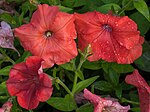In enzymology, a dihydrokaempferol 4-reductase (EC 1.1.1.219) is an enzyme that catalyzes the chemical reaction cis-3,4-leucopelargonidin + NADP+ ⇌ {\displaystyle...
6 KB (535 words) - 06:56, 23 September 2024
Aromadendrin (redirect from Dihydrokaempferol)
or dihydrokaempferol) is a flavanonol, a type of flavonoid. It can be found in the wood of Pinus sibirica. The enzyme dihydrokaempferol 4-reductase uses...
4 KB (192 words) - 03:14, 29 April 2023
flavonoids involves several enzymes. Anthocyanidin reductase Chalcone isomerase Dihydrokaempferol 4-reductase Flavone synthase Flavonoid 3'-monooxygenase Flavonol...
4 KB (333 words) - 19:21, 8 September 2024
reduction. Dihydrokaempferol 4-reductase uses cis-3,4-leucopelargonidin and NADP+ to produce (+)-aromadendrin, NADPH, and H+. Leucoanthocyanidin reductase transforms...
3 KB (143 words) - 00:52, 5 July 2024
Dihydrokaempferol) Engeletin (or Dihydrokaempferol-3-rhamnoside) Flavanone 3-dioxygenase Flavonol synthase Dihydroflavonol 4-reductase Glycosides (chrysandroside...
2 KB (223 words) - 00:40, 4 January 2024
introduction of the second and third hydroxyl group in the B-ring of dihydrokaempferol (DHK) or naringenin which are regarded as the main substrates of the...
19 KB (2,357 words) - 16:32, 10 October 2024
flavanone 3-hydroxylase to form dihydrokaempferol. The compound then reacts with NADPH and dihydroflavonol 4-reductase to form leucopelargonidin, which...
9 KB (817 words) - 10:13, 9 April 2024
petunia, the DFR enzyme does not react with the simplest precursor (dihydrokaempferol); therefore, the natural range of petunia flower colors lacks orange...
18 KB (1,954 words) - 10:24, 13 June 2022
produce pelargonidin. Dihydroflavonol 4-reductases in Iris's relatives selectively do not catalyse dihydrokaempferol to leucopelargonidin, the precursor...
57 KB (5,848 words) - 18:47, 13 September 2024








